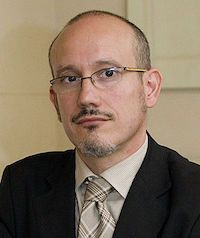Article
Real-World Data of Lacosamide for Focal Seizures Confirms Clinical Trial Outcomes
Author(s):
Outcomes with lacosamide monotherapy for focal seizures in real-world practice were similar to clinical trials but varied with antiepileptic drug history.

Vicente Villanueva, MD
Outcomes and safety experiences with lacosamide (Vimpat) monotherapy for focal seizures in real-world practice were found to be similar to those in clinical trials, although with seizure-free status attained by more patients who received lacosamide as first-line monotherapy than those converted to lacosamide after unsatisfactory or adverse response with other antiepileptic drug (AED) treatments.
Vicente Villanueva, MD, Refractory Epilepsy Unit, Neurology Service, Hospital Universitario y Politécnico, Valencia, Spain, and colleagues in Spain, Italy, and the Netherlands conducted a retrospective review of records for 439 patients with focal seizures, with or without evolution to bilateral tonic-clonic seizures. Each had received lacosamide monotherapy as first- or second-line treatment for at least 12 months prior to the study and had records available for at least 6 months follow-up after baseline.
"Observational studies may complement findings from randomized controlled trials by assessing the effectiveness of an intervention in the patients encountered in daily clinical practice," Villaneuva and colleagues explained.
Lacosamide was first-line monotherapy in 98 patients (22.3%). In the 77.7% who had converted to lacosamide, the most common documented reasons were lack of effectiveness of prior treatment (151/439, 34.4%), intolerance of prior treatment (104/439, 23.7%), or successful experience with lacosamide in combination with another AED (71/439, 16.2%). Baseline demographics were similar between those receiving lacosamide monotherapy initially or as second-line, although there was a higher incidence of focal evolving to bilateral tonic-clonic seizures in the former (54.1% vs 35.5%).
The investigators assessed rates of seizure freedom at the observation points of initiating lacosamide, at 6±3 months, and at 12±3 months after initiation. Other outcomes included retention rates on lacosamide and drug-related adverse events.
Villanueva and colleagues reported higher rates of seizure freedom at approximately 6 months than at 12 months, and higher rates in patients who received lacosamide as first-line monotherapy than as second-line after conversion from another AED regimen (60.2% vs 52.5% at 12 months, 66.3% vs 63% at 6 months).
As might be expected with multiple AED history reflecting more difficult presentation, the seizure freedom rates were higher in patients converting to lacosamide monotherapy after receiving ≤3 lifetime AEDs than in those with ≥3 lifetime AEDs (55.3% vs 31.7% at approximately 12 months).
The retention rates after approximately 12 months were similar between those receiving lacosamide monotherapy as first- and as second-line treatment, but analysis determined a statistically higher rate for those who had converted. In addition, the retention rates were higher in the conversion patients who were ≥65 years of age, while there was no age-related difference in retention in those receiving lacosamide monotherapy as first-line treatment.
Adverse events (AE) were relatively low (11.8% in overall cohort), and it was noted that the most common adverse drug reaction (ADR) of dizziness had occurred at a lower frequency than might be expected from clinical trial experience. The investigators suggest this could reflect more responsive dosing adjustments in real-world practice.
"While the low documented incidence of dizziness may indicate a level of underreporting of less severe AEs in retrospective studies, it may also be possible that the incidence of this ADR is lower in clinical practice due to individualized titration, usually slower than in clinical trials, and dosing," Villanueva and colleagues wrote.
The study, “Lacosamide Monotherapy in Clinical Practice: A Retrospective Chart Review,” was published in Acta Neurologica Scandinavica.



